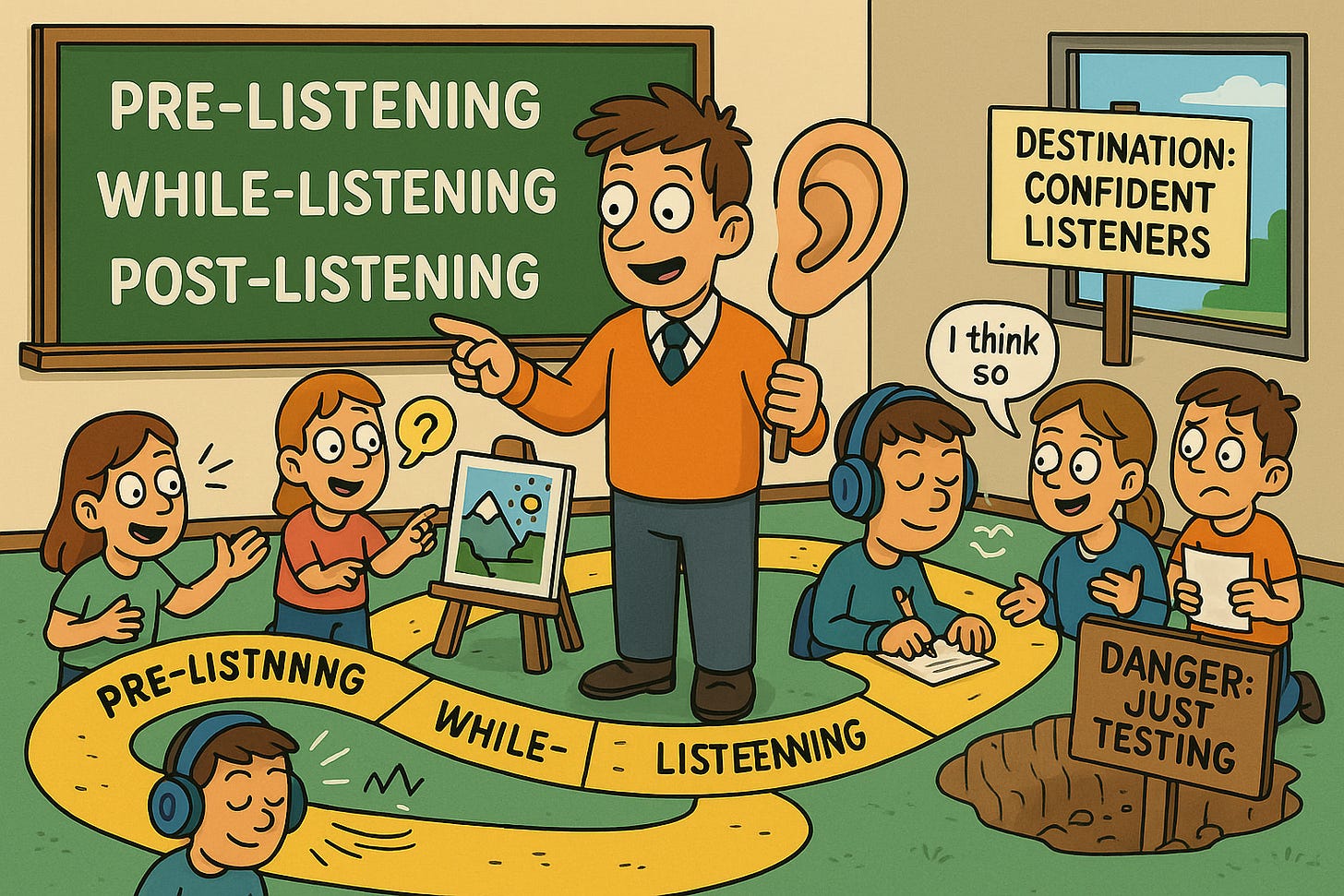How to Teach Listening, Step-by-Step
Make your listening activities engaging and effective
Listening is one of the most important yet overlooked skills in language learning.
Too often, listening lessons end up being nothing more than comprehension tests. Students are told “listen and answer these questions” — and when they get answers wrong, they’re left feeling frustrated instead of better prepared for real-life communication. This approach misses the point: listening is a skill you can teach, not just assess.
In this article, we’ll look at how to turn your listening lessons into skill-building sessions that boost confidence, improve comprehension, and get your students ready for real-world English.
What is Listening in Language Learning?
Listening isn’t just hearing words — it’s an active process of understanding meaning, picking out important details, and making sense of what’s being said.
In language learning, we often use three main types of listening:
Listening for gist (getting the general idea)
Listening for detail (picking out specific information)
Listening for inference (understanding implied meaning)
The most effective lessons train all three.
Why Listening is Essential
Listening is the gateway to speaking fluency. The more your students hear English at natural speed, the better they’ll absorb rhythm, intonation, and pronunciation patterns.
It also builds:
Real-world readiness - handling different accents and speaking speeds.
Vocabulary and grammar awareness - picking up new language in context.
Cultural understanding - hearing how language is used in different settings.
Without listening practice, students miss out on one of the most direct paths to confident speaking.
Why listening is challenging
If your students find listening difficult, they’re not alone. Common challenges include:
Fast speech - native speakers blend words, making boundaries hard to hear.
Over-focusing on unknown words - missing the bigger picture.
Accent variety - being thrown off by unfamiliar pronunciation or intonation.
It’s not just a student problem - many coursebooks encourage a “test, don’t teach” approach. Your job is to flip that.
How to teach listening step-by-step
1. Pre-listening
Set the context — show an image, ask a question, or play a short teaser clip.
Activate background knowledge — ask what students already know about the topic.
Pre-teach only essential vocabulary — avoid spoiling the challenge.
Predict content — get students guessing what they might hear.
2. While-listening
Play the audio more than once, with a different focus each time (gist → detail).
Give a clear, achievable task each time they listen.
Encourage note-taking and picking out key phrases.
Adjust difficulty — beginners can focus on keywords, advanced students on nuance.
3. Post-listening
Pair or group discussion — let students compare answers before checking as a class.
Extend the task — turn the listening into a speaking or writing activity.
Focus on language — highlight useful words or phrases from the recording.
Top tips
Don’t just test — train the skill.
Use a mix of accents, speeds, and contexts.
Keep tasks achievable to build confidence.
Recycle listening texts in later lessons — familiarity builds fluency.
Review AI-generated materials carefully before using them.
Final thoughts
Good listening lessons don’t leave students feeling tested — they leave them feeling trained. With the right structure and a mix of pre-, while-, and post-listening activities, you’ll help students listen more confidently, more effectively, and with far less stress.
If you liked this article, you’ll love my books:
📝 Lesson Planning for Language Teachers - Plan better, faster, and stress-free.
👩🎓 Essential Classroom Management - Develop calm students and a classroom full of learning.
🏰 Storytelling for Language Teachers - Use the power of storytelling to transform your lessons.
🤖 ChatGPT for Language Teacher 2025 - A collection of AI prompts and techniques to work better, faster.
💭 Reflective Teaching Practice Journal - Improve your teaching in five minutes daily.




Yes, exactly. Using listening activities to test learners is unfortunately the go-to method, and we really must change that.
I recently gave a workshop at the LEND Summer school in Salerno on listening, and my first question for the highly proficient and experienced teachers participating was "When was the last time you had a proper in-depth discussion about the issues involved with L2 listening?". The most common answer was "Never". It's no wonder we teachers get listening activities so wrong...
I really appreciate your thoughtful posts here online about teaching. However, in this case, I feel that you skirted around the most problematic issues involved in listening, such as weak pronunciations and/or English rhythm, the multitude of vowel sounds in English compared to many languages - both of which need to be addressed by working much more on pronunciation before any significant results can be achieved.
When learners do not receive that training, when faced with anything which is just above their threshold, they are left wildly stabbing in the dark, making multiple hypotheses about what they are hearing. After a while they go into cognitive overload and need to bail out, almost as if to save their brains from overheating!
So my take is that we need to give them the tools to get almost immediate feedback on their hypotheses, where they can negotiate meaning just as they would in a normal conversation: "Sorry, what did you say? Was it "sleep" or "slip"?" for example. That is how we can help them learn to listen incredibly quickly.
The tools are there. What is missing is the debate